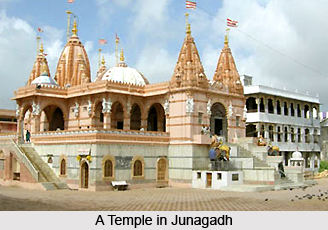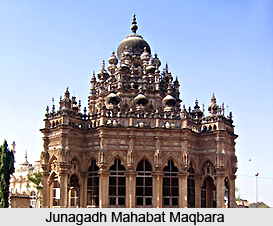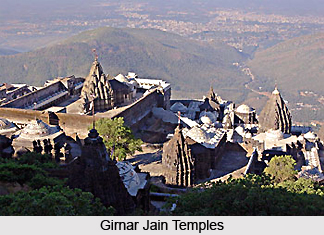 Monuments of Junagadh are rich and varied and have left a lasting impression on the tourist map of Gujarat. Junagadh is the headquarters of the Junagadh district of Gujarat located at the foot of the Girnar Mountain Range. The fort of Uparkot located here is of considerable architectural and historical interest as are the other monuments of Junagadh. The hill town of Junagadh has witnessed the rules of many famous dynasties, like the Maurya Empire, Vilabhis, Chudasamas, Kshatraps, Babi Nawabs and many others. Junagadh was the historic capital of the Mauryan and Gupta Empire in India upto the 5th century AD, the Chudasama Rajputs in the 9th-15th century, the governors of Sorath appointed by the rulers of the Mughal dynasty in the 17th century, and finally the Babi Nawab dynasty upto 1947.
Monuments of Junagadh are rich and varied and have left a lasting impression on the tourist map of Gujarat. Junagadh is the headquarters of the Junagadh district of Gujarat located at the foot of the Girnar Mountain Range. The fort of Uparkot located here is of considerable architectural and historical interest as are the other monuments of Junagadh. The hill town of Junagadh has witnessed the rules of many famous dynasties, like the Maurya Empire, Vilabhis, Chudasamas, Kshatraps, Babi Nawabs and many others. Junagadh was the historic capital of the Mauryan and Gupta Empire in India upto the 5th century AD, the Chudasama Rajputs in the 9th-15th century, the governors of Sorath appointed by the rulers of the Mughal dynasty in the 17th century, and finally the Babi Nawab dynasty upto 1947.
 A number of religious uprisings have also taken place here. All these have greatly influenced the architectural works of Junagadh. A fine specimen of rock-cut architecture is seen here, in the Buddhist caves at Junagadh and the Ashokan edicts. Also influences of the grand Mughal architectural style are also prevalent as seen in the Jami masjid found here. Monuments of Junagad display a fine mix of the different architectural styles that were prevalent in the region centuries ago under different rulers. Having been under Hindu, Jain, Buddhist and Islamic rule at one time or another, the monuments found here display a wide variety.
A number of religious uprisings have also taken place here. All these have greatly influenced the architectural works of Junagadh. A fine specimen of rock-cut architecture is seen here, in the Buddhist caves at Junagadh and the Ashokan edicts. Also influences of the grand Mughal architectural style are also prevalent as seen in the Jami masjid found here. Monuments of Junagad display a fine mix of the different architectural styles that were prevalent in the region centuries ago under different rulers. Having been under Hindu, Jain, Buddhist and Islamic rule at one time or another, the monuments found here display a wide variety.
The Swami Narayan Temple is one of then most important religious monuments of
Junagadh. The temple was built by Lord Swaminarayan himself. The land on which this temple is built was donated for the purpose by Jinabhai Darbar of Panchala. Within the temple are seen idols of Shri Ranchodji and Shri Trivikramray Dev, Shri Harikrishna Maharaj and Shri Siddheshwar Mahadev. The murti of Bhagwan Swaminarayan is posed in a lunch posture especially made as per the instruction of Sadguru Nityanand Swami for worship in his daily puja.

A cluster of beautiful Jain temples are found located halfway up the Girnar Hills. The most beautiful temple here is that of Neminath, dedicated to the 22nd Jain Trithankara.
Located at the top of the Girnar Hills is the temple of Amba Mata. The temple was built in the twelfth century. The temple is dedicated to Goddess Ambaji. A folk drama, the Bhavai dance, is performed in the temple courtyard. The temple is a very popular site for the newlyweds who come here to seek blessings of the divine.
To the north of the sacred bathing tank of the Damodar Kund is the Damodarji temple. It is an ancient temple believed to have been built by the Vajranabha, the great-grandson of Lord Krishna.
On the way to the Girnar Talati is the Gayathri mandir and vageshwari mandir. It houses the temples of goddess Gayatri and goddess Vigneshwari. Navaratri is a special time of the year as a mela is held here every year.
Besides the religious edifices the monuments of Junagadh also include several historical ones.



















